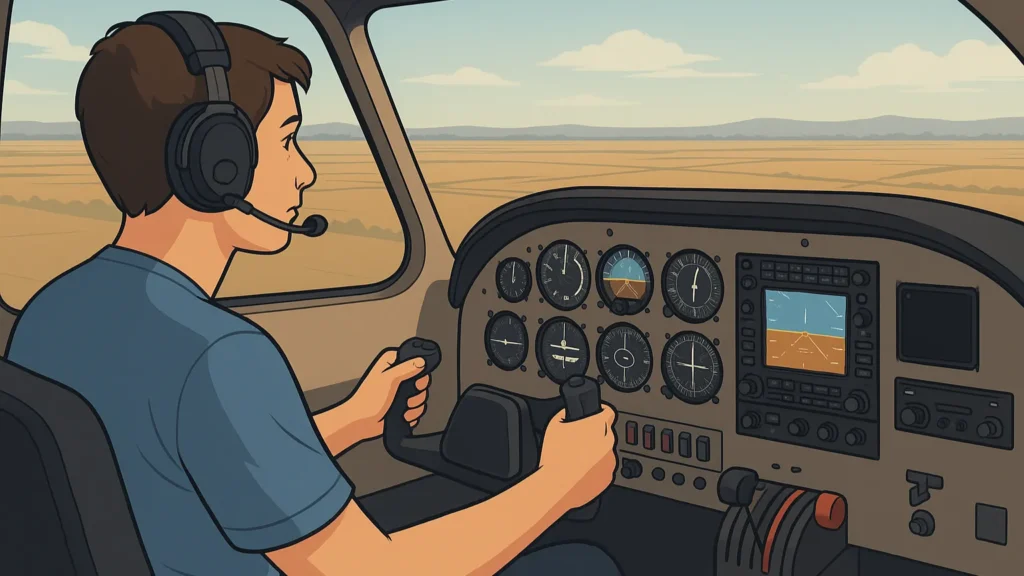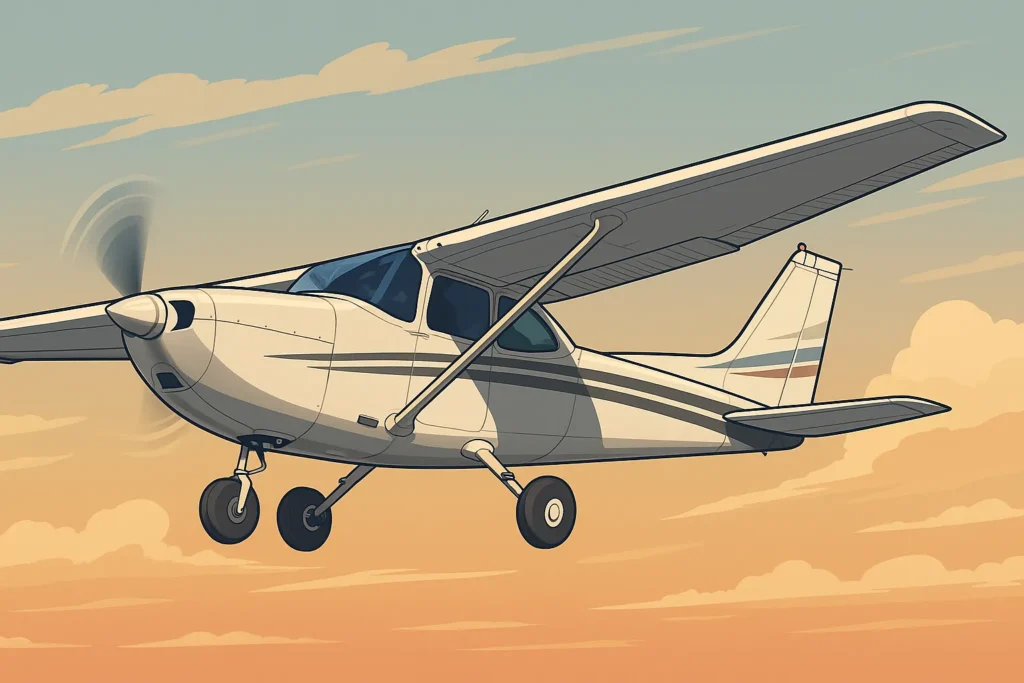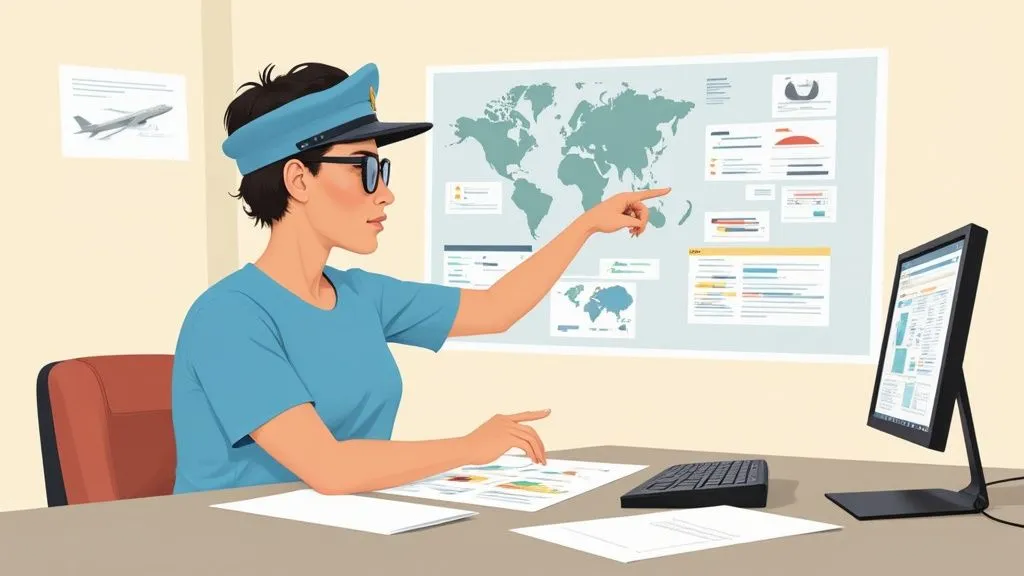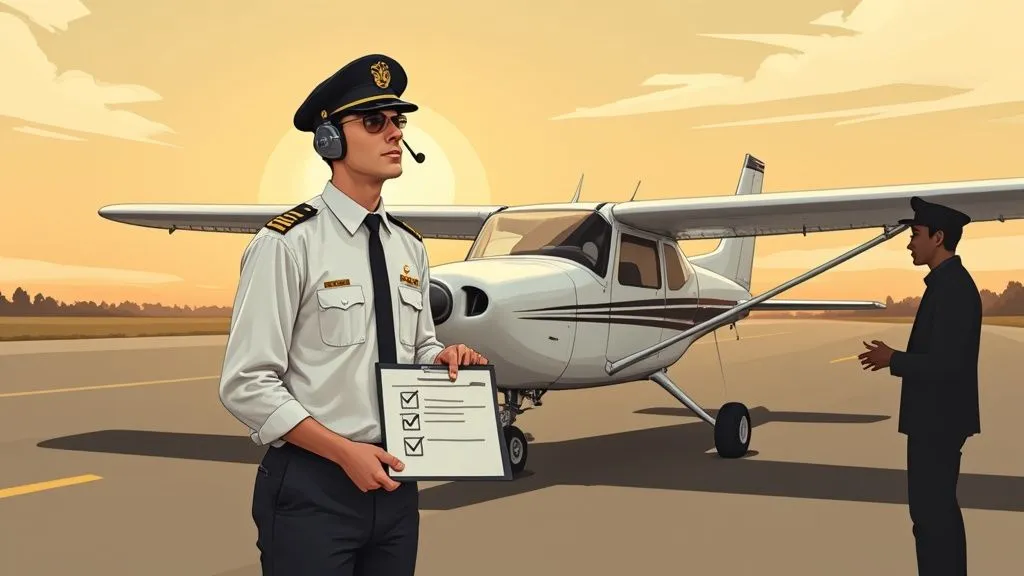Understanding What Really Happens During Your Test
The private pilot checkride, a milestone often met with a mix of excitement and nerves, represents the culmination of your flight training. It’s the final hurdle before you can take to the skies as a certified pilot. But what actually takes place during this critical assessment? Let’s break down the checkride process, from the moment you arrive to that final, well-earned handshake.
From Arrival to Takeoff: Setting the Stage For Success
The checkride starts well before you enter the cockpit. Your arrival, initial interaction with the Designated Pilot Examiner (DPE), and the document review are all important first steps. Organized paperwork, a calm and professional demeanor create a positive first impression for the entire evaluation. Being prepared not only with your knowledge but also in your presentation is crucial.
Read also: How to master the DPE interaction
The Oral Exam: More Than Just Rote Memorization
The oral examination is a discussion about your understanding of aviation fundamentals, not simply a question-and-answer session. The DPE evaluates your thought processes, your ability to articulate complex ideas, and your capacity for safe aeronautical decision-making, not just whether you know the right answers. This is where thorough preparation truly pays off.
Taking to the Skies: Demonstrating Your Practical Skills
The flight portion of the checkride puts your practical piloting abilities under scrutiny. The DPE will assess your proficiency in various maneuvers, ranging from standard takeoffs and landings to more advanced procedures like steep turns and stalls. They’ll also be observing your situational awareness, your responses to unexpected events, and your adherence to safety regulations. It’s not solely about stick-and-rudder skills; it’s about showing you can operate an aircraft safely and effectively as pilot-in-command.
Performance Standards and Examiner Expectations
The private pilot checkride, formally known as the practical test, is a significant assessment for aspiring pilots. Pass rates offer an insight into training effectiveness. In 2023, the first-time pass rate for the private pilot checkride in the United States, as reported by the FAA, was 74.5%. This indicates that about three out of four candidates succeed on their first attempt. Find more detailed statistics here.
However, statistics only paint part of the picture. Success hinges on understanding what examiners truly seek: a blend of technical skill, sound judgment, and a safety-focused mindset. This comprehensive approach distinguishes successful candidates and sets checkride expectations apart from regular training flights.
Preparation Strategies That Actually Work
Passing your private pilot checkride isn’t simply about accumulating flight hours. It’s about preparing effectively. Memorizing procedures alone won’t guarantee success. Instead, successful candidates use specific study techniques and practical exercises to ensure they’re truly ready.
Balancing Knowledge Review with Practical Application
Successful checkride preparation requires a balanced approach. This involves dedicating time to reviewing important concepts and also honing practical skills in the aircraft. It’s similar to learning a musical instrument. You need to understand music theory, but you also need to practice playing the instrument. Aspiring pilots must grasp theoretical knowledge and consistently practice flight maneuvers.
The Power of Scenario-Based Training
While rote memorization has its uses, true understanding comes from applying knowledge to real-world situations. Scenario-based training lets you experience the challenges and decision-making demands of actual flight. This approach helps build the critical thinking skills essential for passing your checkride.
For example, practicing emergency procedures in a simulator prepares you to react calmly and effectively during an actual emergency. Research indicates pilots using systematic preparation and scenario-based training have a 68% higher first-time pass rate than those relying solely on traditional methods.

Organizing Your Resources and Mastering Communication
Effective organization is crucial for checkride success. This means having a well-structured system for your reference materials, allowing you to quickly find necessary information. Clear and concise explanations of complex concepts demonstrate a solid understanding to the examiner.
How to prepare for your private pilot checkride
Identifying Your Weak Spots and Building Confidence
One of the most valuable strategies is identifying personal weaknesses before the checkride. This allows you to focus your preparation efforts where they’re most needed. It’s like a golfer practicing their putting; they identify weaknesses and work to improve those specific areas. Similarly, aspiring pilots should identify their challenging maneuvers or knowledge areas and dedicate extra practice time to them. This focused approach builds confidence and reduces pre-test anxiety.
Managing Pre-Test Anxiety
Finally, managing pre-test nerves is essential for optimal performance. Developing coping mechanisms, like deep breathing exercises or visualization techniques, can help maintain calm and focus during the checkride. This enables you to demonstrate your true abilities without being hindered by anxiety. This preparation goes beyond simply passing the test; it sets the foundation for a confident and successful flying career.
Mastering the Oral Examination
The oral examination is a critical part of your private pilot checkride. It sets the stage for the entire experience and demands focused preparation. It’s more than just reciting facts; it’s about showing a genuine grasp of the concepts and principles behind safe flight.
Understanding the Examiner’s Perspective
Examiners aren’t just listening for the right answers. They are evaluating your thought processes, your ability to apply knowledge to real-world situations, and your overall aeronautical decision-making. They want to see that you can think critically and make sound judgments, especially under pressure. This means preparation involves more than memorization; it requires a deep understanding of the material.
Demonstrating Genuine Understanding
Think of it like explaining a complex topic to a friend. You wouldn’t simply list facts and figures. You’d explain the underlying principles, give examples, and answer their questions clearly and concisely. The oral exam is similar. You need to demonstrate true understanding.
One effective technique is scenario-based training. By practicing various scenarios, you build the critical thinking skills needed for real-world situations. This helps you confidently address unexpected challenges during the checkride.
Effective Communication Under Pressure
The oral exam also assesses your ability to communicate effectively under pressure. Examiners want clear, concise, and well-organized answers. They’re looking for your ability to think on your feet and articulate your thoughts effectively, a vital skill for safe flight operations during your checkride and beyond.
Key Knowledge Areas and Success Strategies
Certain knowledge areas frequently appear in oral examinations. Knowing these key areas and having effective strategies to address them will significantly improve your chances of success. The following table, “Essential Oral Exam Topics and Success Strategies,” provides critical knowledge areas, typical examiner questions, successful preparation approaches, and key references to help you excel.
The following table provides a starting point for your preparation, highlighting key areas to focus on. Remember, the examiner is looking for genuine understanding, not just rote memorization.
| Knowledge Area | Typical Questions | Success Strategy | Key References |
|---|---|---|---|
| Regulations | What are the privileges and limitations of a private pilot? | Understand the FAR/AIM and be able to explain regulations clearly. | FAR/AIM |
| Weather | How would you interpret this weather report? | Practice interpreting weather reports and making go/no-go decisions. | Aviation Weather Resources |
| Aircraft Systems | Explain the function of the fuel system. | Be prepared to describe systems and explain their operation in detail. | Pilot Operating Handbook |
| Flight Planning | How would you plan a cross-country flight? | Practice creating flight plans using various resources. | Navigation Charts and Flight Planning Tools |
Turning Weak Spots into Strengths
Identifying your weak areas before the checkride is crucial. This allows you to focus your study efforts and turn potential weaknesses into strengths. Practicing challenging concepts and maneuvers not only improves your skills but also builds your confidence. Turning weaknesses into strengths helps you pass the checkride and builds a solid foundation for your future as a pilot.
Flight Test Performance and Common Mistakes
The flight portion of your private pilot checkride is where you truly demonstrate your command of the aircraft. It’s not simply about executing maneuvers perfectly; it’s about showcasing your judgment, situational awareness, and ability to operate safely under pressure. This section explores what examiners assess during each phase of the flight test, highlights common errors, and offers valuable tips for success.

Maneuvers: Precision and Understanding
Accurate execution of maneuvers is fundamental, but examiners also evaluate your comprehension of the principles behind each one. For instance, performing a stall recovery isn’t enough. You also need to articulate why the recovery steps are essential and how they influence the aircraft’s aerodynamics. This deeper understanding demonstrates that you’re not just memorizing procedures but actively applying your knowledge.
Examiners also observe your aircraft management during each maneuver, assessing smoothness, coordination, and overall control. Consistent practice and attention to detail are key here. Smooth transitions between maneuvers demonstrate proficiency and contribute to a favorable impression.
Decision-Making and Situational Awareness
Beyond technical skill, examiners assess your aeronautical decision-making (ADM). They want to see how you evaluate risks, consider options, and make informed choices. How would you respond to a sudden weather change? Your reaction reveals your judgment and commitment to safety. For more information on ADM, check out How to master aeronautical decision-making.
Maintaining situational awareness is equally critical. Examiners evaluate your ability to track your position, monitor instruments, and anticipate potential hazards. A solid grasp of situational awareness ensures you’re always ahead of the aircraft and prepared for any contingency.
Common Mistakes: Bridging the Gap Between Training and Testing
Many pilots excel in training but falter during the checkride. One reason is the shift in mindset. Training flights often concentrate on individual skills, while the checkride assesses your overall performance as pilot-in-command. Analysis shows that 73% of flight test failures occur during basic maneuvers, not complex scenarios, often due to inadequate preparation for standard procedures. Learn more about checkride failures here.
Another frequent error is ineffective communication with the examiner. Clearly explain your intentions and thought processes throughout the flight. This transparency demonstrates understanding and builds confidence in your abilities.
Handling Unexpected Situations: Turning Challenges into Opportunities
Unexpected events can occur during any flight, including the checkride. The examiner may introduce simulated emergencies or route deviations. These aren’t tricks but opportunities to showcase your adaptability and composure.
View these challenges as chances to demonstrate your skills. By staying calm, applying your knowledge, and communicating effectively, you can exhibit competence and professionalism.
Demonstrating Professional Competence
Your overall demeanor and professionalism are essential. Maintain a respectful and professional attitude throughout the examination. This includes punctuality, appropriate attire, and a positive outlook. You’re demonstrating your readiness to be a certificated private pilot, and your professionalism reflects your commitment to aviation safety and standards. By focusing on these key areas, you can improve your performance and enhance your chances of checkride success.
Understanding Pass Rates and What They Really Mean
Knowing the industry statistics surrounding the private pilot checkride gives valuable context to your own journey. Examining pass rate trends offers insights into training effectiveness and preparation strategies. This understanding helps normalize the experience and clarifies what these numbers truly represent.
Why Retests Are Normal, Not a Sign of Failure
Even highly skilled pilots sometimes need a second attempt at the checkride. This isn’t a reflection of their abilities, but rather an indication of the high standards of aviation certification. The checkride isn’t simply about demonstrating basic skills.
It’s about showing a complete understanding of safety, regulations, and decision-making. This comprehensive evaluation makes sure that only qualified people earn their pilot certificates.
The number of people pursuing pilot certifications also impacts the overall statistics. A higher testing volume naturally leads to more passes and disapprovals. This means interpreting the numbers requires a nuanced understanding of the bigger picture.
For example, in 2023, checkride disapprovals reached 22,860, up from 13,891 in 2021. While this might seem concerning, it aligns with the increase in total test attempts due to a rise in certification applications. Find more detailed statistics here.
The Importance of Training Volume and Quality
The amount and quality of training significantly affect checkride outcomes. Sufficient flight hours and solid ground school preparation build the necessary foundation for success. This preparation is like building a house: a strong foundation is essential for stability.
Likewise, comprehensive flight training prepares pilots for the demands of the checkride. However, just logging hours isn’t enough; the type of training matters.
Scenario-based training lets pilots apply their knowledge to realistic situations, enhancing decision-making under pressure. This focused practice boosts confidence and improves chances of success.
How hard is it to become a private pilot?
The Retest Process: A Path to Improvement
A retest offers a chance to refine skills and address any weaknesses identified during the first attempt. It’s a chance to learn and return better prepared. The retest process is like refining a sculpture; each attempt shapes the final outcome.
Similarly, every checkride attempt hones the pilot’s skills and solidifies their understanding.
Regional Variations and Their Significance
Pass rates can vary by region due to factors like examiner consistency, training methods, and local conditions. Understanding these variations provides helpful perspective. Remember, the checkride is a standardized assessment designed to ensure pilot proficiency regardless of location.
By understanding what these statistics truly indicate, you can approach your private pilot checkride with confidence and focus on your preparation, regardless of industry-wide trends.
Global Perspectives on Private Pilot Testing
Gaining insights into how other countries certify their private pilots offers valuable perspective as you prepare for your own checkride. By examining the practical testing structures of various aviation authorities, you can uncover common threads of safety standards and training philosophies.
International Standards and Benchmarking
Aviation safety is a global concern. Maintaining consistent standards across international borders is crucial for safe flight operations worldwide. This collaborative approach to aviation safety helps ensure a high degree of safety and pilot proficiency, regardless of where a pilot earns their certification. International benchmarks for private pilot checkride standards and pass rates often look to leading aviation authorities like the FAA in the US or EASA in Europe. While direct comparisons can be difficult due to varying regulatory details, the FAA’s extensive data often serves as a valuable reference. Learn more about pass rates here.
Recognition and Conversion Processes
Pilots certified under one regulatory system may need to complete a conversion process to have their credentials recognized in another country. This often involves demonstrating compliance with the new jurisdiction’s regulations and successfully completing a checkride for private pilot certification. These procedures are vital for maintaining consistent standards across different regions. They enable pilots trained in one country to operate safely and legally in another.
Training Methodologies and Success Rates
Some training methodologies have demonstrably higher success rates globally. For instance, training programs that incorporate scenario-based training and aeronautical decision-making (ADM) tend to produce pilots who are better equipped to handle real-world flying challenges. This proactive approach helps build essential critical thinking skills.
International Best Practices: Enhancing Your Preparation
Looking at best practices from around the world can be a great way to enhance your checkride preparation. European programs frequently emphasize deep theoretical knowledge, fostering a strong understanding of fundamental flight principles. Other regions may prioritize practical decision-making skills, cultivating strong situational awareness.
European Emphasis on Theoretical Knowledge: A rigorous grounding in aviation theory ensures pilots have a strong foundation in the principles of flight. This encourages in-depth understanding that goes beyond rote memorization of procedures.
Focus on Practical Decision-Making Skills: Programs centered on practical decision-making skills equip pilots to confidently manage real-world scenarios. These programs prepare pilots to make quick, informed decisions in dynamic flight environments.
These varied approaches highlight the diverse pathways to pilot competency. Understanding these different perspectives can broaden your own approach to training and enhance your checkride readiness.
The Value of Thorough Preparation and Rigorous Standards
A global perspective reinforces the importance of thorough checkride preparation. Earning your private pilot certificate is a substantial accomplishment, recognized internationally. The rigorous testing standards ensure pilots around the world meet a high level of competency. This global recognition underscores the significant dedication and skill required to become a certified pilot.
Final Preparation and Test Day Success
The final weeks before your private pilot checkride are critical. This is the time to refine your skills and knowledge so you can perform your best on the big day. Think of it as the final rehearsals before a major performance. You’re not learning new material, but polishing what you already know. This includes organizing your paperwork, managing pre-test jitters, and making sure everything is in place for your examination day.
Organizing Your Documents and Materials
Having all your required documents readily available minimizes stress and demonstrates professionalism. Just like you wouldn’t go to a job interview without your resume, you shouldn’t show up for your checkride without your pilot certificate, medical certificate, logbook, and other necessary paperwork. Being organized shows the examiner you’re prepared and serious about aviation. This not only streamlines the process but also projects competence.
Managing Pre-Test Nerves: Staying Calm and Focused
Pre-test nerves are perfectly normal. However, excessive anxiety can hinder performance. Employing effective stress management techniques, such as deep breathing and visualization, is vital for staying calm and focused. Visualize yourself successfully completing each phase of the checkride, from the oral exam to the flight maneuvers. This mental preparation can build confidence and reduce anxiety.
Weather Planning and Contingency Strategies
Weather can be unpredictable, so having backup plans is essential. Check the weather forecast frequently leading up to the checkride, and have alternate dates in mind if necessary. Much like a ship’s captain plans alternate routes, you too should have a plan B. This demonstrates foresight and a proactive approach to flight safety.

Final Review: Maintaining Confidence and Identifying Weak Areas
Balancing confidence with acknowledging areas needing improvement is key in your final review. Focus on your strengths while dedicating extra time to any remaining weaknesses. This is similar to a musician practicing a piece: they play the whole piece while focusing on the more difficult passages. Review all the material, but concentrate on any maneuvers or concepts that still feel uncertain. This approach keeps your skills sharp and boosts confidence.
Rest, Focus, and Professionalism
A good night’s sleep before your checkride is crucial for optimal performance. Adequate rest ensures you’re mentally alert and ready. Maintaining focus during the exam itself is equally important. Minimize distractions and concentrate on the task at hand. Projecting professionalism throughout the entire checkride process is essential. Dress appropriately, arrive on time, and maintain a respectful attitude toward the examiner. Learn more in our article about How to Impress Your Designated Pilot Examiner on Checkride Day. Combining rest, focus, and professionalism presents you in the best possible light.
Checkride Day Preparation: A Practical Checklist
To help organize everything for your checkride, a comprehensive checklist can be incredibly valuable. The table below outlines essential documentation, preparation tasks, and contingency plans for a successful checkride experience.
| Preparation Area | Required Items | Completion Timeline | Backup Options |
|---|---|---|---|
| Documentation | Pilot certificate, medical certificate, logbook, government-issued photo ID, aircraft documents | 1 week prior | Photocopies, digital scans |
| Aircraft | Ensure airworthiness, fuel reserves, necessary equipment | Day before | Alternate aircraft, reschedule |
| Personal | Adequate rest, appropriate attire, review materials | Day before/Day of | Contingency plans for delays |
| Weather | Check forecasts, consider winds and visibility | Day before/Day of | Alternate dates, flexible schedule |
| Knowledge | Review regulations, procedures, and flight planning | Ongoing, final review 1 week prior | Flashcards, practice tests |
This checklist will help you ensure that everything is in order. Remember, thorough preparation is the cornerstone of checkride success. It calms nerves, builds confidence, and prepares you for the responsibilities of a certificated pilot.
Your Private Pilot Checkride Is a Test of Skill, Not Perfection
Your private pilot checkride is more than just a test. It’s a reflection of everything you’ve learned and practiced throughout your flight training. Success doesn’t come from chasing perfection; it comes from preparation, self-awareness, and a calm, safety-first mindset. From mastering the oral exam to confidently executing maneuvers in the sky, every step is an opportunity to demonstrate that you’re ready to act as pilot-in-command.
Whether it’s your first attempt or a retest, what truly matters is your commitment to becoming a safe, competent aviator. Approach the checkride with the same professionalism and care that you would bring to any flight. With thorough preparation, a clear understanding of examiner expectations, and confidence in your abilities, you’ll be well on your way to earning your private pilot certificate, and taking the left seat with pride.
Recent Posts
FAA MOSAIC Final Rule: What Pilots, Manufacturers, and the Aviation Community Need to Know
Learn how the FAA’s MOSAIC final rule revolutionizes Light-Sport Aircraft certification, expands Sport Pilot privileges, and reshapes general aviation. See what’s changing, when it takes effect,...
Student Pilot Insurance: Essential Coverage for Aspiring Flyers
Discover how student pilot insurance can protect your flying dreams. Get expert tips and coverage options to ensure your safety and peace of mind.


